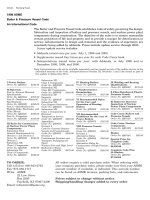Process Engineering Equipment Handbook 2009 Part 7 pdf
Bạn đang xem bản rút gọn của tài liệu. Xem và tải ngay bản đầy đủ của tài liệu tại đây (2.69 MB, 80 trang )
C-322 Condition Monitoring; Condition-Monitoring System(s); Engine Condition Monitoring; Engine Condition–Monitoring System(s)
FIG. C-348 Critical speed map.
13
then
w
n
<w
nt
Therefore, we see that flexibility lowers the natural frequency of a system. This is
diagrammatically represented in Fig. C-348, which can be extended to include 2nd,
3rd, and higher critical speeds.
Figure C-349A shows vibration modes of a uniform flexible shaft supported at
both ends by rigid supports.
Figure C-349B shows a rigid rotor supported by flexible supports.
The critical speed concept theory outlines the identification of the operating range
of a rotor-bearing system, probable mode shapes, and approximate locations of peak
amplitudes.
Forced vibration. In forced vibration the usual driving force in rotating machinery
is the shaft speed or multiples of this speed. Note the characteristics of forced and
self-excited vibration in Table C-29.
The speed becomes critical when excitation frequency is equal to one of the
natural frequencies of the vibration.
In forced vibration the system is a function of frequencies that can be multiples
of rotor speed excited by frequencies other than 1¥ rpm. They might be blade-
passing frequency, gear-teeth frequency, and so forth.
For forced vibration, critical frequency remains the same for any shaft speed.
Damping reduces the amplitude of forced vibration but does not change critical
speed values.
Campbell diagram. Figure C-350 is a representation of a Campbell diagram. The
Campbell diagram is an overall view of all the vibration excitations that can occur
on an operating system. The numbered lines (numbers with a circle around them)
are engine order lines. For illustration purposes, the second stage compressor blade
has been theoretically represented. We see that operating the compressor at a
specific speed range—12,000 rpm—will excite the 200-Hz first harmonic (200 Hz =
200 ¥ 60 = 1200 rpm). This range should be avoided.
Condition Monitoring; Condition-Monitoring System(s); Engine Condition Monitoring; Engine Condition–Monitoring System(s) C-323
FIG.
C-349A Rigid supports and a flexible rotor.
13
FIG. C-349B Flexible supports and rigid rotors.
13
TABLE
C-29 Characteristics of Forced and Self-Excited Vibration
13
Forced or Self-excited or
Resonant Vibration Instability Vibration
Frequency/rpm N
F
= N
rpm
or N or Constant and relatively
relationship rational fraction independent of rotating speed
Amplitude/rpm Peak in narrow bands Blossoming at onset and continues
relationship of rpm to increase with increasing rpm
Influence of damping Additional damping Additional damping may defer to
Reduce amplitude a higher rpm
No change in rpm at Will not materially
which it occurs affect amplitude
System geometry Lack of axial symmetry Independent of symmetry
External forces Small deflection to an
axisymmetric system
Amplitude will self-propogate
Vibration frequency At or near shaft Same
critical or natural
frequency
Avoidance Critical frequency above Operating rpm below onset
running speed
Axisymmetric Eliminates instability
Damping Introduce damping
To ensure that blade stress levels are within fatigue life requirements, one might
strain gauge the blading on prototype test models to measure stress levels. An
impeller might also be mounted on a shaker table with variable frequency output
(0–10,000 Hz). Accelerometers can be mounted at various positions on the impeller
and used with a spectrum analyzer to record frequency response. See Figs. C-351
and C-352.
The results of all these tests may be plotted on a Campbell diagram, such as Fig.
C-353. Lines of excitation frequency are vertical lines on the diagram. The design
speed is represented by a horizontal line. When lines of excitation frequencies and
multiples of running speed intersect near the line of design running speed, there
may be a problem.
C-324 Condition Monitoring; Condition-Monitoring System(s); Engine Condition Monitoring; Engine Condition–Monitoring System(s)
FIG. C-350 Campbell diagram.
13
In the case, for instance, of an impeller with 20 blades, a design speed of
3000 rpm (or 50 Hz), and a critical frequency of 1000 Hz, the impeller may have a
serious problem at these conditions (the intersection of the running speed line,
1000-Hz frequency line, and line of slope 20 N) as its critical is 20 N.
Introduction to balancing using influence coefficients
The theory of balancing using influence coefficients will not be dealt with fully
here as it involves some cumbersome mathematics. However, this technique
Condition Monitoring; Condition-Monitoring System(s); Engine Condition Monitoring; Engine Condition–Monitoring System(s) C-325
FIG.
C-351 Accelerometer locations on impeller tested.
13
FIG.
C-352 Impeller showing nodal points.
13
C-326 Condition Monitoring; Condition-Monitoring System(s); Engine Condition Monitoring; Engine Condition–Monitoring System(s)
FIG. C-353 Campbell diagram of tested impeller.
13
is incorporated into modern multiplane balancing machines today. The accuracy
of these machines is possible because of advances in sensor technology and
minicomputers.
Consider a rotor with n discs. Let P, P, ,P
n
be the forces acting on the shaft.
Then the deflection Z
i
in the ith plane is given by:
This equation defines the compliance matrix [e
ij
] and the elements of the matrix are
called influence coefficients. The compliance matrix is obtained by making
P
j
=d
y
where d
y
is the Kronecker delta, and measuring deflections and Z
j
. As j is varied
from 1 to n, each column of the compliance matrix is developed.
Knowing the initial vibration in each plane q
i
, the system of equations
is solved for the correction forces. The correction weights can be computed from the
correction forces.
In balancing with influence coefficients:
Initial unbalance amplitudes and phases are recorded
Trial weights are inserted sequentially at selected locations along the rotor
Resultant amplitudes and phases are measured at convenient locations
Required corrective weights are computed and added to the system
This method requires no foreknowledge of the system dynamic response
characteristics. If it were available it would help in selecting more effective readout
locations and trial weights.
Influence coefficients examine relative displacement rather than absolute
displacements. Damping or initially bent rotors do not affect the process.
Introduction to modal balancing
The modal balance technique will not be discussed in detail in this course. It does,
however, involve equating the deflection of a rotor at any speed to the sum of various
modal deflections multiplied by constants that depend on speed. So a rotor that has
been balanced at all critical speeds will then be balanced at all other speeds. The
basic procedure for a rotor with end bearings is to first balance the shaft as a rigid
body, then balance for all critical speeds in the operating range, then balance out
any noncritical modes at the running speed.
Typical principal modes (1st, 2nd, and 3rd) for a symmetric and uniform shaft
are illustrated in Fig. C-354.
Modal balancing, mathematically speaking, is based on the fact that a flexible
rotor may be balanced by eliminating the effect of the unbalance distribution in a
mode-by-mode sequence. The deflections of a rotor at any speed may be represented
by the sum of various modal deflections multiplied by constants dependent on speed.
where represents the amplitude of transverse vibrations, as a function of
the distance along the shaft at a rotational speed w. and h
r
(x) express the
complex coefficient at rotating speed w and the rth principal mode, respectively.
In other words a rotor that is balanced at all critical speeds is also balanced at
any other speed. For end bearing rotors, the usual procedure is:
B
r
w
()
Yx,w
()
Yx B x
rr
r
,wwh
()
=
()
¥
()
=
•
Â
1
eF q i n
ij j
j
n
==
=
Â
1
1
1, , ,
ZePi n
iijj
j
n
==
=
Â
1
1, , ,
Condition Monitoring; Condition-Monitoring System(s); Engine Condition Monitoring; Engine Condition–Monitoring System(s) C-327
1. Balance the shaft as a rigid body.
2. Balance for each critical speed in the operating range.
3. Balance out the remaining noncritical modes as far as possible at the running
speed. Balance planes picked are the ones where maximum amplitudes of
vibration occur.
Modal balancing has severe limitations. Calculated values for mode shapes and
natural frequencies must be computed. Input data may limit the accuracy of these
figures. Then, when damping is significant, such as in the case of fluid film bearings,
problems arise. Damped modes look very different from undamped ones, so
predicting modes and frequencies can be a severe problem. No one has overcome
this to the extent that this method can be used as influence coefficients can in
modern balancing machines.
Surge Control; Pressure and Flow Transducers
Optimum performance of driven equipment (compressors and pumps) enhances
delivery of revenue product. A great deal of effort is, therefore, spent determining
the parameters that affect turbomachinery performance. These include capacity,
pressure ratio, power (and therefore fuel) consumed, and the surge characteristics
of the machine.
Surge describes the condition when pressure at the suction drops to the extent
that the flow reverses on itself. In a compressor, it first occurs on individual blades.
This is called stall or rotating stall. Fully developed rotating stall is surge. In a
pump, the surge phenomenon is called cavitation. Both surge and cavitation destroy
equipment in what may be disastrous failures.
C-328 Condition Monitoring; Condition-Monitoring System(s); Engine Condition Monitoring; Engine Condition–Monitoring System(s)
FIG.
C-354 Typical principal modes for a symmetric and uniform shaft.
13
Performance analysis of driven equipment, whether done for test or for normal
operation, generally requires that the following readings be taken:
1. Inlet temperature
2. Inlet pressure
3. Discharge temperature
4. Discharge pressure
5. Compressor speed
6. Atmospheric pressure
7. Differential pressure across the flowmeter
8. Temperature at the flowmeter
9. Pressure at the flowmeter
10. Fluid (gas, liquid) properties
The preceding properties determine the mass flow through the machine, based on
volume flow, pressure and temperature readings, and fluid properties. The gas
properties help work out the revenue base for the delivered fluid. For instance, gas
may be sold to customers based on a certain heat value per unit time.
Mass flow ¥ calorific value of fuel per unit mass = heat delivered per unit time
As field composition changes, molecular weight frequently changes so gas
composition analysis should be done regularly. If done frequently, changes in gas
composition may provide early warning of a declining field.
All flow and pressure measurement devices require certain minimum lengths of
straight pipe prior to measurement stations. A length of 10 pipe diameters is
considered good practice. If piping is protracted and tortuous, accurate
measurement may be difficult. Valves in the system must have the right closure
speed characteristics and leak-tight properties.
Pressure measurement
Pressure measuring devices include the following:
1. Pitot static tubes
2. Pressure transmitters and transducers
3. Barometers
4. Liquid manometers
During commissioning, startup screens are used to protect the machine against
welding slag and other inclusions left in the piping during construction. They cause
a sizable differential drop, however, and should be removed.
Manometers are frequently used to measure differential pressures and
atmospheric pressure. They should be calibrated regularly. It is important to watch
for trapped bubbles within the liquid because they can make a reading inaccurate.
Inlet and discharge pressures are the sum of the static pressure and the velocity
pressure at the respective points.
Flow transducers
Fluid (gas and liquid) flow through compressors and pumps (driven equipment) is
measured by appropriate measuring transducers. These transducers include:
Condition Monitoring; Condition-Monitoring System(s); Engine Condition Monitoring; Engine Condition–Monitoring System(s) C-329
1. Venturi tubes. These consist of a convergent section at the entrance, a constant
diameter throat, and a divergent section. They are accurate but hard to retrofit.
They should be planned for in advance.
2. American Society of Mechanical Engineers (ASME) flow nozzle. This is
essentially little used in the field as it is hard to fit in a process plant. It works
well in test rigs.
Items 1 and 2 handle about 60 percent more flow than orifice plates.
3. Orifice plates. Orifice plates are mostly the concentric orifice type, although an
eccentric orifice might be used, depending on the quantity of fluid to be
measured.
4. Elbow flowmeters. Centrifugal force at the elbow is used to find the difference
between the inside and the outside of the elbow. This is then related to discharge
pressure.
There are many other techniques that are more theoretical, better suited for lab
work, or require complex data to be supplied by the OEM.
Nonintrusive Wear Monitoring
Nonintrusive wear monitoring is a technique where neutron bombardment is used
to determine the state of wear of a bearing in a nonintrusive wear. The technique
was pioneered on lower-temperature machinery such as diesels. Although it is
dropping in price, it is still expensive. The wear monitors are relatively bulky, which
has not helped their popularity.
Since its introduction, vibration techniques and performance analysis techniques
have developed well and dropped in price. It is unlikely that nonintrusive wear
monitoring will ever rival contemporary vibration and temperature monitoring for
detecting bearing failures. It may make a comeback when development budgets are
not tight.
References and Additional Reading
1. Soares, C. M., “Aspects of Aircraft Engine Monitoring Systems Experience as Applicable to Ground
Based Gas Turbine Engines,” TMC, 1988.
2. Soares, C. M., “Design, Installation and Operation of Turbomachinery in Western Canadian Gas and
Oil Production,” ASME IGTI, 1981.
3. Lifshits, Simon, and Smalley, “More Comprehensive Limits for Rotating Machinery,” ASME Journal
for Gas Turbines, vol. 108, October 1986.
4. Lifson et al., “Assessment of Gas Turbine Vibration Monitoring,” ASME-GT-204.
5. Floyd, “Key Issues and Technology for Future Programs,” Proceedings Fifteenth Annual SFTE
Conference.
6. “An Overview of Airborne Vibration Monitoring (AVM) Systems,” Society of Automotive Engineers,
SAE 871731.
7. Vibration seminar notes, Mechanical Technology Incorporated.
8. Aspects of Flexible Rotor Balancing, 2d ed., Schenk Treble, January 1976.
9. Simmons and Smalley, “Effective Tools for Diagnosing Elusive Turbomachinery Problems in the
Field,” ASME 89-GT-71.
10. Balancing of Jet Engines, Schenk Treble, A1511.
11. Soares, C. M., “Vibration Analysis: Separating the Elements of Machinery, Process and Personnel,”
TMC, 1992.
12. Soares, C. M., “Latest Techniques in Repair Technology,” TMC, 1990.
13. Boyce, turbomachinery course notes, 1979.
14. Soares, C. M., “Condition Monitoring,” Asian Electricity, 1997.
15. Bloch, H., machinery failure analysis and troubleshooting course notes.
16. Gunter, “Rotor Bearing Stability,” Proceedings First Turbomachinery Symposium, 1972.
17. Thomson, Mechanical Vibrations, 2d ed., Prentice Hall, Englewood Cliffs, NJ, 1961.
18. Buscarello, R., vibration course notes, 1980.
19. Handbook on vibration, McGraw-Hill, New York.
20. Bloch, H., and Soares, C. M., Turboexpanders and Process Application, Gulf Professional Pub., 2001.
Control Regulators (see Actuators)
C-330
Control Systems; Controls C-331
Control Systems; Controls
A control system is what controls and governs an operating system or part of that
system. The field of controls and control systems is wide enough to fill several
handbooks on its own. However, in this more general book, we shall attempt to
highlight certain common aspects and systems of process controls with examples.
We have selected systems that have, when malfunctioning, missing, or wrongly
applied, caused the bulk of control-related problems in operating plants in the major
process industries. This selection of features and systems will also illustrate where
other problems with control system elements might be found.
A control system can be represented by a schematic pressure and instrument
(P&I) line diagram. Its scope may vary. For instance we have a control system that
runs an overall plant, a control system that runs a gas turbine package (driver,
driven compressor, and all auxiliaries), and a control system that governs part of
that overall package (say compressor) or one (say stator blade movement) or more
of its functions. Several control systems for compressors are looked at in some
detail.
Control Systems of Turbocompressors*
Two main requirements are to be met by the control system of turbocompressors.
See Figs. C-355 through C-357.
Safety: to prevent the compressor from operating in an unstable range or at other
hazardous conditions
Process: to adapt the compressor performance to the demands of the process
FIG. C-355 Antisurge control system and combined discharge pressure/power limit control system.
SC 1, speed controller; E/HGY, electrohydraulic converter; PDT, differential pressure transmitter;
TT, temperature transmitter; PT, pressure transmitter; GT, position feedback transmitter; ST, speed
transmitter; FY, computer; GC, positioning controller; SC 2, load limit controller; UY 3, function
generator; FC, volume controller; PC, pressure controller; BC, antisurge controller; UY 2, minimum-
selection relay; HC, reference value station; HIC, manual station. (Source: Sulzer-Burckhardt.)
* Source: Sulzer-Burckhardt, Switzerland. Adapted with permission.
The control systems may be pneumatic or electronic with hydraulic or
electromechanical servomotor. In cases where the compressor control system is
engineered or furnished by others, it is customary to review and approve the
system in order to ensure the compatibility of all equipment and functions. With
employment of standard signals, the control system can be integrated into other
systems, including safety systems, without difficulty: it allows remote control,
automation of starting and stopping, and integration with process computers.
Safety systems
Antisurge control.
Turbocompressors have a limited stable operating range,
regardless of the type of blading and other influencing factors. This range is given
by the characteristic curves limited by the surge lines. Surge conditions, occurring
on the left side of this surge line, are avoided by an antisurge control system. It
measures flow and pressure and can be designed to closely follow the actually
measured surge line at a given safety margin. See Fig. C-358.
As soon as the operating point approaches the surge line, the controller starts
opening the antisurge valve according to the preset values (L).
For air compressors, the excess capacity is blown off to the atmosphere.
C-332 Control Systems; Controls
FIG. C-356 Electronic control cabinet. (Source: Sulzer-Burckhardt.)
FIG. C-357 Example of a monitoring panel. (Source: Sulzer-Burckhardt.)
For a gas that cannot be wasted to the atmosphere, antisurge control is a bypass
control, the unwanted flow being returned to the suction side. A bypass cooler may
then be required.
The antisurge control system is not a flow or pressure control device, but a safety
device that has to act independently of any other control.
Vibration, temperature, pressure, power limitation. Under certain circumstances
external influences may lead to undesired changes of the normal level of vibration,
gas, and bearing temperatures, pressure, and power. A reliable interlock, alarm,
and shutdown system must protect the compressor and driver from possible damage
under such conditions.
Auxiliary component control. Auxiliary component control ensures a safe supply of
lube, control, and seal oil.
Process parameters
Suction pressure.
Constant suction pressure to adapt the compressor flow to an
upstream production unit or to maintain a constant evaporation temperature for
refrigerating units.
Discharge pressure. Constant discharge pressure in cases where chemical reactions
have to take place at a clearly defined pressure, or where the compressor flow has
to be adapted to a fluctuating downstream demand.
Flow. Constant mass flow control corresponding to a constant plant output.
Typical process control system A (see Fig. C-355)
System for either capacity control and pressure limitation or pressure control with
capacity limitation.
The capacity is measured by means of a Venturi tube. The computer FY receives
input signals from the differential pressure transmitter (PDT), pressure transmitter
(PT), and temperature transmitter (TT) and calculates the actual capacity value for
the flow controller (FC).
The FC and the pressure controller (PC) are each equipped with one manual
station HIC for the reference value. By way of the minimal-selection relay UY2,
the volume or pressure controller acts upon the positioning controller GC of the
stator blade adjusting mechanism. The positioning circuit for the stator blade
adjusting mechanism comprises the positioning controller GC, the electrohydraulic
converter GY, and the position feedback transmitter GT.
Control Systems; Controls C-333
FIG. C-358 Characteristics of a turbocompressor. p = discharge pressure, V = flow rate, C =
compressor characteristic curves, S = surge line, L = limit flow. (Source: Sulzer-Burckhardt.)
Load limit control
Malfunctioning in the steam or condensate system of the driving turbine may lead
in certain circumstances to an undesired drop in speed. In such cases, the stator
blades will be closed to such an extent by the load limit controller SC 2 that the
speed will remain nearly constant. The speed controller SC 2, which is equipped
with the reference value station HC, receives its input signal from the speed
transmitter ST and has priority over the process controller with minimal selection
relay UY 2, when necessary.
Antisurge control system
The system will maintain stable operation of the compressor, even when the process
operating point moves into the unstable range of the compressor performance
characteristic.
The PT is used to determine the actual value. A PDT and a function generator
UY 3 are employed for setting the reference value. This computer enables the
response line (blow-off line) to be well adapted to the surge limit. The output signal
of the antisurge controller BC acts by way of the minimum selection relay UY 2 on
the positioning controller GC of the blow-off valve. The valve can also be opened by
the manual station HIC and override the antisurge controller. The positioning
circuit for the blow-off valve comprises the positioning controller GC, the
electrohydraulic converter GY, and the position feedback transmitter.
Typical process control system B
Suction pressure: constant suction pressure to adapt the compressor flow to an
upstream production unit or to maintain a constant evaporation temperature for
refrigerating units
Discharge pressure: constant discharge pressure in cases where chemical
reactions have to take place at a clearly defined pressure, or where the compressor
flow has to be adapted to a fluctuating downstream demand
Flow: constant mass flow control corresponding to a constant plant output
Figure C-359 shows an antisurge control system for a centrifugal compressor
having practically constant suction conditions. The pressure differential
transmitter (PDT) is used to determine the actual volume. A pressure transmitter
(PT) and a function generator UY1 are used to set the reference value for the
antisurge controller. This computer enables the response line (blow-off line) to be
well adapted to the actual surge limit. The output signal of the antisurge controller
BC acts upon the actuator of the blow-off valve by way of the minimum selection
relay UY2 via positioner GY. The valve can also be opened by the manual station
HIC independently of the antisurge controller.
The discharge pressure control system with power limit control regulates the
adjustable inlet guide vanes. The pressure controller PC receives its actual value
from pressure transmitter PT and the set value from the manual station HIC. The
power limit controller EC receives the corresponding values from the power
converter ET and manual station HC. By way of the minimal selection relay UY2,
the pressure or power controller acts upon the actuator of the inlet guide vanes
through the electric/pneumatic converter GY.
Features of the system
Frequently, the OEM supplies the entire control, safety, and instrument system.
Their experience comprises various suppliers of equipment for all types of drivers
and most diverse process applications. OEMs commonly offer:
C-334 Control Systems; Controls
Responsibility of compressor and driver control/safety system
Design and construction of instrumentation and panels in accordance with all
kind of standards
Engineering and supply of instrumentation and panels for the entire compressor
train, including driver, in line with clients specifications and incorporating all
considerations resulting from actual operational experience with compressor
trains of similar duty
Experience with various suppliers of instruments and control/safety equipment
Full functional test of instrument panel in the works
Simple interface in case of use of a process computer
Monitoring logic
The monitoring logic supervises various controller reference values, the speed of
the set, time-dependent operations such as startup and the positioning of the final
control elements. The system facilitates the determination and processing of any
disturbances in the final positioning elements and transmitter signals.
General system layout
The control system of these axial compressors is designed for all types of drive and
diverse process applications.
Transmitter according to the 2-wire system; standard signals 4–20 mA
Isolating amplifier in the case of external measurement data
Plausibility supervision for the determination of measurement data faults
Output tracking for automatic changeover to manual control made in case of
measurement failure
Impulse technique of the control units
Control Systems; Controls C-335
FIG.
C-359 Antisurge control system and combined discharge pressure/power limit control system.
(Source: Sulzer-Burckhardt.)
Positioning elements driven by hydraulic servomotors and controlled by
electrohydraulic converters
Two changeover contacts for each output for alarm and control purposes
Controls, of Airfoil Movement
For example, Figs. C-360 and C-361 show an axial compressor where the intake flow
may be governed by automatic control of variable stator vanes. In the event
of a control oil pump failure, the compressor stator blades fail closed. See Fig. C-362.
Controls, of Lube and Seal Oil Systems*
Any item of turbomachinery or a turbomachinery train must have a lube and seal
oil system or an oil system where the lube and seal oil have separate circuits of
their own (see Fig. C-357). Figure C-363 is a P&I diagram of an intercooled
centrifugal compressor. An example of a standard lube oil supply system is shown
in Fig. C-364. A seal oil system for floating ring seals (standard for API packages)
is depicted in Fig. C-365.
Lube oil unit
The standardized lube oil units are generally available in two versions: according
to the OEM’s standard and the API standard 614. See Figs. C-366 and C-367. The
major components of a unit are the oil tank, auxiliary oil pump, double filter, and,
selectively, one or two oil coolers. All components of the smaller units are mounted
on a common bedplate, while the oil tank of a big unit is mounted on its own
bedplate, separated from the other components. The oil can be heated up by an
electrical or steam-heating unit. The necessary instrumentation is a standard
supply item and, if requested, the switches and motors can be wired up. The main
oil pump is driven preferably by the gear unit of the driving machine. A separate
drive arrangement is also possible.
Seal oil unit
When floating ring seals are used, seal oil (or seal water) is required. A seal oil unit
according to API standards, either separate or combined with the lube oil unit, is
available. Besides the oil tank, two oil pumps, double filter, and cooler, which are
the basic components of any oil supply system, the seal oil unit comprises also an
overhead tank that creates the static seal oil overpressure and a degasifier drum
with nitrogen injection.
Control of Overload and Overspeed (of Gas Turbines)
Protection of gas turbines against overload and overspeed
†
Gas turbine generator sets (see Fig. C-368), particularly aeroderivative gas
turbines, are sensitive to electrical fault events that can damage the gas turbine.
Mechanical protection—i.e., with a torque-limiting coupling—is in many cases not
C-336 Control Systems; Controls
*Source: Sulzer-Burckhardt, Switzerland. Adapted with permission.
†
Source: J.M. Voith GmbH, Germany.
Control Systems; Controls C-337
FIG. C-360 Automatic process flow control by means of adjustable stator blades. (Source: Sulzer-Burckhardt.)
C-338 Control Systems; Controls
FIG.
C-361 Remote setting of adjustable stator blades used to control process flow. (Source: Sulzer-Burckhardt.)
Control Systems; Controls C-339
FIG. C-362 Oil supply schematic for an axial compressor. (Source: Sulzer-Burckhardt.)
C-340 Control Systems; Controls
FIG.
C-363 Typical P&I diagram of an intercooled compressor. (Source: Sulzer-Burckhardt.)
Control Systems; Controls C-341
FIG. C-364 Lube oil supply unit, P&I schematic. (Source: Sulzer-Burckhardt.)
C-342 Control Systems; Controls
FIG. C-365 Seal oil system for floating ring seals; API equivalent system. (Source: Sulzer-Burckhardt.)
Control Systems; Controls C-343
FIG.
C-366 Lube oil unit. (Source: Sulzer-Burckhardt.)
FIG. C-367 Lube oil unit according to API 614. (Source: Sulzer-Burckhardt.)
possible because of potential overspeed of the turbine after the release of the
coupling.
A method for protection of gas turbines against overtorque and overspeed is
described below. The overspeed limitation is achieved through the incorporation of
a hydrodynamic coupling, acting as a brake.
A gas turbine generator set normally consists of three major mechanical
components, a gas turbine, a gearbox, and a generator.
These components are connected with couplings that besides transmitting the
torque also must be able to cope with the misalignment and the displacement
caused by the temperature gradients in the system.
The generators operate at standard speeds, 1500 (1800) rpm or 3000 (3600) rpm.
The gas turbine speed differs with the individual turbine design from 3600 to
20,000 rpm, typically.
A gearbox that reduces speed is required in practically all generator set designs.
The gear ratio can be as high as 12 times and different types of gearboxes are used.
Aeroderivative gas turbines are based on aircraft engines with only minor
design modifications. The lightweight design however also makes the turbines more
sensitive to the overloads that can appear when there is a malfunction in the
system.
Fault conditions. From a power transmission point of view the drive during normal
running conditions can be considered as smooth with small variations in the torque.
The overtorque that can appear, and which has to be considered in designing the
system, is a rare failure event.
If we discount mechanical failures, the main potential source for overtorque is
the generator.
Electrical fault conditions in the generator can produce a large overtorque
that is transmitted back to the system: the turbine, the gearbox, and the power
transmission components.
The electric fault possibilities are
Malsynchronization
Short circuit
Both events involve torque peaks at the generator output shaft of a magnitude ten
times full load torque (10¥ FLT). The peaks are of short duration and the torque is
pulsating with the frequency of the generated current. Malsynchronization only
gives few torque peaks while in a short circuit situation the pulsation of the torque
can go on for some seconds.
The nature and exact size of the torque peaks are well defined and normally
known by the generator manufacturer.
How the torque peaks are transmitted backward through the system is governed
by the inertia and the stiffness of the components involved.
The situation is complex and a dynamic analysis of the torque fault conditions
is normally required for determination of the torque that reaches the gas
turbine.
Torque-limiting requirements. The turbine itself, which also is the most costly item,
is in many cases the weakest link that has to be protected. The requirement for
C-344 Control Systems; Controls
FIG.
C-368 Gas turbine generator set, general layout. (Source: J.M. Voith GmbH.)
Control Systems; Controls C-345
limiting the torque can in many cases be difficult. As examples, both the Allison
501-KB7 and GE’s LM 6000 need protection at approximately 2–2.5 ¥ FLT in certain
configurations.
Compared to most other drives protected with torque-limiting couplings the
relation between the requested torque limit and the FLT is unusually small. A
shearpin coupling is inadequate for such applications.
Basic design. The basic design principle of this OEM’s (Safeset
®
) coupling is to
transmit the torque through a frictional joint in which torque capacity is controlled
by hydraulic pressure. This coupling type connects a gear to a shaft in Fig. C-369.
If the coupling is exposed to a higher torque than it can transmit over the
frictional joint it will slip there. The relative movement of this slippage cuts a valve
(shear tube) with a shear ring so the hydraulic pressure, the contact pressure, and
consequently the transmitted torque drop to zero. The drop in torque occurs in a
few milliseconds.
This coupling has some basic advantages that has made it an appropriate solution
in certain gas turbine generator set applications.
The torque limit is not influenced by high fatigue and remains practically
unchanged after a large number of load cycles. The coupling will thus not release
unneccesarily.
The torque limit is adjustable and can be set at low levels, i.e., 1.4–1.6¥ FLT and
thereby protect components that have to operate close to their limits.
The resetting of the coupling after release is quick and reliable so the downtime
of the unit is minimized.
Typical applications outside of the power generation field are very highly loaded
steel mill drives and pump drives in the chemical industry, where production
downtime costs can be extremely high.
Overspeed and overspeed limits. When a gas turbine is mechanically disconnected
from the workload and inertia of the generator it will momentarily increase speed.
The magnitude of the speed increase is controlled by the residual energy in the
system, i.e., the amount of fuel that is available and how it progresses to flame out.
The overspeeding is also controlled by the inertia that is accelerated by the
residual energy. Therefore there is a significant influence based on where in the
drivetrain the mechanical disconnection takes place.
If the separation is made between the gearbox and the generator, the
overspeeding gas turbine will have to accelerate not only its own inertia but also
the inertia of the gearbox, which will result in a lower peak speed.
Speed is a critical design factor for a gas turbine and any overspeeding requires
certain actions depending on how much the speed is exceeded.
Such actions could be:
Inspection of the turbine
Removal and complete disassembly
For the operation and for reducing the hazards it is important to reduce the
overspeed, and this can be done by including a hydrodynamic coupling in the
drivetrain.
The requirements on the turbo coupling are limited by letting the coupling rotate
at speed and only react to the speed difference between gas turbine and generator.









